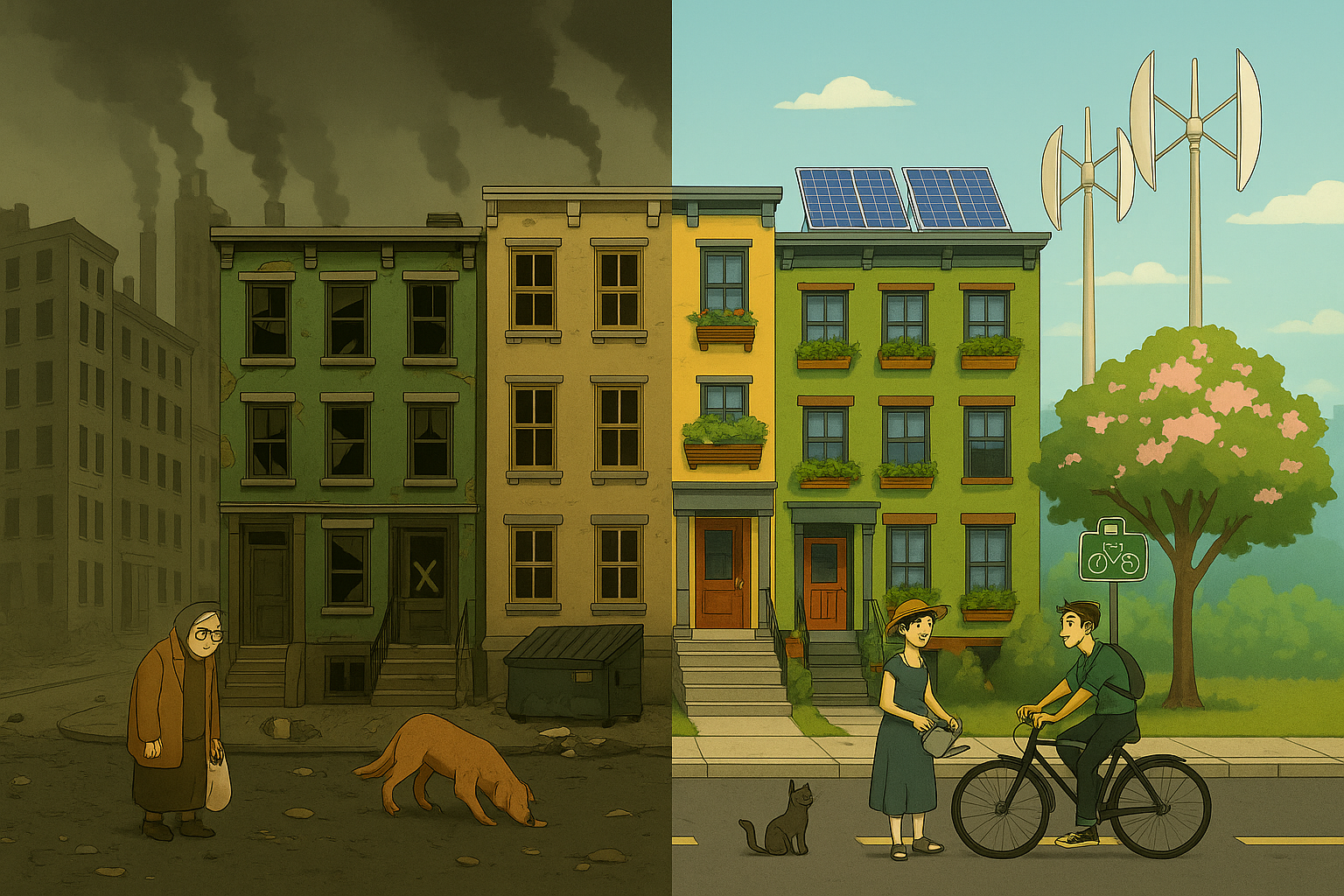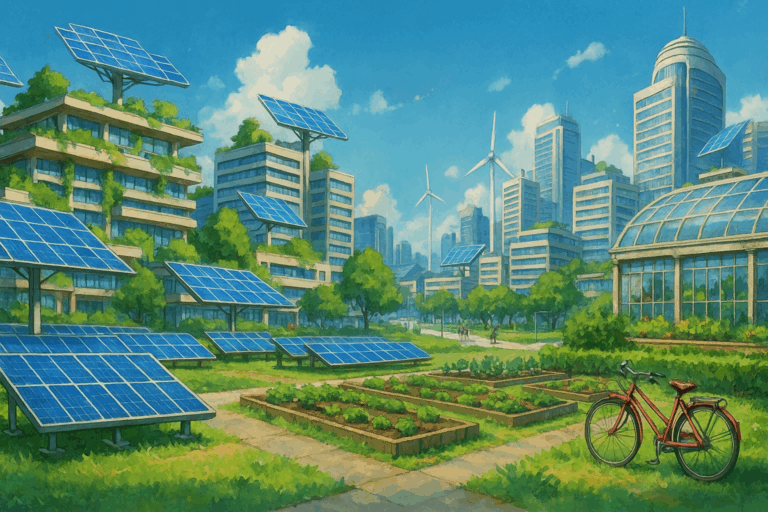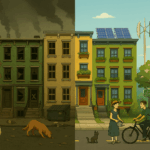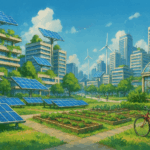I live in a city where the air smells like diesel and the gutters are filled with iridescent pools of petroleum and unknown chemical runoff. The rivers are choked with forgotten wrappers and the skyline is dotted with buildings that serve as monuments to the waste and excesses of late-stage capitalism. Everywhere I look, it’s profit over people, growth over health, convenience over survival.
It may sound pessimistic — even a touch hyperbolic — but it reflects the scale of the crisis we face and the fierce urgency with which we must respond.
The world is indeed slowly unraveling. Climate catastrophe isn’t on the horizon — it’s already here. Wildfires rage, floods displace, and the air is thick with more than just smog; it carries the weight of systemic collapse. The institutions we were taught to trust are eroding, and the supposed stewards of progress cling to dying paradigms of extraction, exploitation, and endless growth. We can’t wait for rescue. It’s time to revolt.
Solarpunk is part of that revolt. It’s not about asking for permission or waiting for billionaires to save us with technological fixes. It’s about building new systems in the shell of the old ones, hacking our lives to reduce harm, and refusing to normalize a future built on planetary ruin. This is a revolution you can grow in your window box, wire to your balcony, and organize on your block. Solarpunk is about reclaiming autonomy and remaking the world, piece by piece, with hope as our strategy and action as our weapon.
One of the most empowering ways to begin is by harnessing the sun. For homeowners, rooftop solar panels can drastically reduce both carbon emissions and utility costs. But you don’t need to own your home to participate. Renters and apartment dwellers can use portable solar panel kits, balcony-mounted units, or solar-powered battery packs to generate and store clean electricity. These systems make renewable energy more accessible and offer small but meaningful steps toward energy independence.
Alongside solar energy, small-scale wind power is an often-overlooked but valuable tool in the urban solarpunk toolkit. Vertical-axis wind turbines, which are quieter and more compact than traditional models, can be mounted on rooftops or balconies to supplement solar generation. These devices work well in windy urban corridors and during overcast periods, providing power when sunlight is limited. As with solar, combining wind with battery storage increases energy reliability and helps you cut the cord from centralized systems.
Globally, buildings account for 39% of energy-related carbon emissions — 28% from daily operations and 11% from construction materials and processes (Architecture 2030). This means that our homes are among the most important fronts in the fight against climate change. Choosing renewable energy isn’t just a personal win; it’s a collective necessity.
Of course, producing energy is only part of the equation — storing it is just as crucial. Compact home battery systems allow you to capture excess solar or wind power for use at night or during outages. Paired with smart inverters, these systems can run critical appliances and help reduce reliance on fragile municipal grids, making your home more resilient in times of uncertainty.
Not every solarpunk upgrade is flashy — some of the most impactful changes happen quietly. Retrofitting your home for efficiency can yield major benefits: switching to LED lighting, installing low-flow faucets, using programmable thermostats, and adding insulation or thermal curtains to regulate indoor temperatures. These small adjustments collectively reduce energy and water use, while improving comfort and lowering monthly expenses.
Remodeling with a solarpunk ethos means rethinking materials, design, and purpose. Use reclaimed wood, recycled steel, and salvaged components wherever possible to reduce demand on raw resources. Look for building supplies certified by programs like Cradle to Cradle or the Forest Stewardship Council, which ensure sustainable sourcing. Choose natural insulation options like sheep’s wool or hempcrete, and explore clay-based or lime plasters instead of synthetic drywall. Seek out paints and finishes that are non-toxic and low in volatile organic compounds. Your home shouldn’t just shelter you from a collapsing world — it should stand as a quiet protest against it.
Plastic pollution is one of the most pervasive problems facing our environment, and cutting it out of our daily lives is essential to living solarpunk. Plastics have infiltrated nearly every corner of modern urban existence. According to National Geographic, about 8 million metric tons of plastic waste enter the oceans each year — the equivalent of one garbage truck every minute (source). From food packaging and kitchen supplies to bathroom shelves and our wardrobes, the presence of plastic is nearly constant. But small changes add up.
A good place to start is in the bathroom: swap liquid shampoos and conditioners in plastic bottles for solid bars like HiBAR or Ethique that come in recyclable or compostable packaging. Replace toothpaste tubes with chewable tablets such as Bite Toothpaste Bits packaged in glass jars or tins. In the kitchen, avoid cling wrap by covering dishes with beeswax wraps like those from Bee’s Wrap, placing a glass pot lid or bowl over food, or using a ceramic plate as a cover. Replace plastic scrubbers and synthetic sponges with loofah sponges or natural dish brushes made from wood and plant fibers, which are fully compostable and effective for both personal hygiene and cleaning tasks.
Even our clothing contributes to plastic waste — synthetic fabrics like polyester and nylon shed microplastic fibers with every wash. Opt instead for natural fibers like organic cotton, hemp, linen, or bamboo. Prioritize second-hand clothing to reduce demand for new production and extend the life cycle of existing garments. The fashion industry is responsible for 10% of global carbon emissions and uses more water than any industry other than agriculture, according to the United Nations Environment Programme (source). To further reduce microplastic pollution, use microfiber-catching laundry tools like the Guppyfriend washing bag or install a Filtrol filter on your washing machine. According to a study published in Environmental Science & Technology (Browne et al., 2011), a single synthetic garment can release over 1,900 microfibers in just one wash. These microplastics are too small to be filtered out by wastewater treatment plants and often end up in rivers, lakes, and oceans, where they are ingested by aquatic life and enter the food chain. Globally, it’s estimated that laundering synthetic textiles accounts for up to 35% of all primary microplastics released into the environment, making it one of the largest known sources of microplastic pollution. Microfiber filters and wash bags are not just accessories — they’re vital mitigation tools in a world awash in plastic fibers. For truly 100% natural fiber clothing, look for smaller, mission-driven brands such as Rawganique or Lifekind, which focus on organic and plastic-free textiles. Extending the life of clothing by just 9 months can reduce carbon, water, and waste footprints by 20–30%, according to UK nonprofit WRAP (source).
Being intentional about what we bring into our homes — and what we send back out — is a core solarpunk value. In addition to plastic swaps in the bathroom and kitchen, you can take further steps throughout your daily routine. Carry a reusable shopping bag, water bottle, and coffee cup to replace disposable alternatives. Choose bar soaps and refillable cleaning products like those from Blueland or Etee over disposable containers. Store leftovers in glass jars or stainless steel containers, such as traditional Indian-style tiffin boxes, instead of plastic tubs. Trade disposable razors for safety razors such as those from Leaf Shave. Swap plastic toothbrushes for bamboo alternatives like Brush with Bamboo. Even mindful grocery shopping — such as buying in bulk or choosing unpackaged produce — can significantly reduce household waste over time.
By reducing plastic dependency, we not only limit our personal environmental impact but help build momentum toward a cultural shift that values durability, biodegradability, and ecological responsibility.
The same principles of self-sufficiency extend to food production. Urban agriculture is a key tenet of solarpunk living, and there are plenty of ways to grow your own food, even in a high-rise. Hydroponic and aeroponic towers can flourish on balconies, while vertical gardens and window-mounted planters bring green life into kitchens and living rooms. Community rooftop gardens and neighborhood growing co-ops provide additional space and the chance to collaborate with others, reinforcing both sustainability and social connection.
Water and waste systems also offer opportunities for transformation. Solarpunk living means embracing ecological cycles and closing the loop where possible. Greywater diverters, for example, allow lightly used water from sinks and showers to be reused for irrigation. Composting, including worm bins adapted for apartment use, turns food scraps into soil instead of landfill waste. And in some areas, compact rainwater harvesting barrels can be installed to provide a low-impact source of water for gardens and plants.
Beyond the individual home, solarpunk living thrives on community networks. Joining a local energy cooperative or a shared solar project brings people together to decentralize power — literally and figuratively. Tools, knowledge, and surplus resources can be shared via neighborhood groups or platforms like Buy Nothing, reinforcing a culture of mutual support and waste reduction. Community becomes not just a buzzword but a resilient infrastructure.
Transportation plays a role in this reimagining of urban life. Bicycling is more than a commute alternative — it’s a quiet rebellion against car culture. Choosing to bike, even occasionally, reduces emissions, improves health, and reconnects us with our surroundings. For those with longer distances to travel, electric bikes offer a practical and efficient compromise. Bike-friendly infrastructure is on the rise in many cities, making this lifestyle shift more accessible than ever.
The solarpunk mindset also encourages us to challenge ideas about waste. Dumpster diving — or, more broadly, urban salvaging — may seem fringe, but it directly counters the wastefulness of modern consumer culture. Perfectly usable food, furniture, and goods are discarded daily. Rescuing and repurposing them not only saves resources but also raises awareness of systemic inefficiencies. Many solarpunks view food rescue and material reclamation as both ethical and revolutionary acts.
All of these efforts gain power when supported by strong, localized communities. Community organizing, from garden co-ops to skill-sharing workshops, transforms sustainability into something bigger than personal lifestyle. Hosting repair cafés, creating tool libraries, or starting a mutual aid group doesn’t just solve immediate problems — it seeds long-term resilience and fosters a sense of collective ownership over our shared future. doesn’t just solve immediate problems — it seeds long-term resilience and fosters a sense of collective ownership over our shared future.
Underlying it all is the spirit that gives solarpunk its edge: the “punk” itself. This isn’t just a movement of green tech and urban gardens — it’s a challenge to the norms that led us to climate crisis and social inequality. Solarpunk embraces DIY ethics, resistance to wasteful systems, and joyful defiance of the idea that a better world isn’t possible. It thrives on creativity, accessibility, and disruption of what’s considered “normal.” Even something as simple as repurposing discarded materials into art or building your own composting system is a political act rooted in optimism and agency.
And while function matters, so does form. A solarpunk home should inspire — filled with biophilic design, natural light, greenery, and decor that celebrates sustainability. Upcycled furniture, indoor plant walls, and colorful textures turn your home into not just a refuge, but a living expression of the future you believe in.
Living solarpunk in a city isn’t a distant dream — it’s a series of small, achievable steps that can radically transform your life and your surroundings. From rooftop farms to shared battery systems, from neighborhood potlucks to reclaimed wood furniture, every choice becomes part of a broader cultural shift.
But individual choices alone aren’t enough. To create lasting change, we must also wield our collective power at the ballot box. Voting is not just a duty; it is an act of vision. It’s not enough to vote based on short-term interests or narrow agendas. We must vote for the long-term health of our communities, ecosystems, and the generations that will follow us. Support candidates who champion bold climate policies, sustainable development, environmental justice, and decentralized infrastructure. Push for legislation that transforms energy, housing, agriculture, and transportation systems at scale. Solarpunk living must be paired with political will — and that means turning out to vote, every election, for the future we want to build.
The solarpunk revolution is already growing. And it can start right at your doorstep. To quote British explorer and environmental activist Robert Swan, “The greatest threat to our planet is the belief that someone else will save it.”






